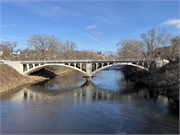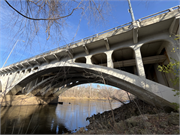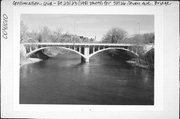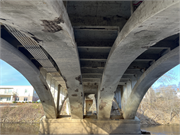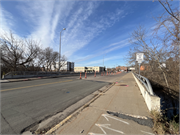| Additional Information: | 1981 SURVEY INFO: The Dewey Street Bridge, which crosses the Eau Claire River, is a double span reinforced concrete structure. A new deck and railings were added in ca. 1979. The bridge should be re-evaluated once more information on the state's bridges is available.
1987 SURVEY UPDATE: This bridge was reconstructed since the 1981 survey. The same design appears in the archways and supports. The deck, railings and sidewalks were reconstructed with a newer railing design.
Total length is 216.5 feet; longest span is 107 feet.
2018
The Dewey Street Bridge was constructed in 1931 and designed by Eau Claire city engineer Carl F. Meyer. The bridge carries two lanes of Dewey Street traffic over the Eau Claire River. It is a two-span, open-spandrel, reinforced-concrete arch bridge. The overall length of the structure is 216.5 feet with an overall bridge width of 42 feet, including 8-foot sidewalks. It underwent extensive renovations in 1978 and 1981. This included a rehabilitation of the substructure, which also moved city infrastructure to the interior of the bridge arches. The original deck has been removed and replaced, the sidewalks have been widened, and the character-defining feature—the original classical-inspired railing—was replaced with a modern concrete and steel tube parapet
2024: The Dewey Street Bridge is a two-span, open spandrel, reinforced concrete rib-arch bridge. The bridge was constructed in 1931 and the superstructure was replaced in 1979. The bridge has an overall length of 216.4 feet and consists of two 107-foot spans, each with a 32-foot rise. It has an overall width of 60 feet which includes a 42-foot-wide roadway and 9-foot-wide, cantilevered sidewalks on both sides.
The bridge has concrete abutments and integrated wingwalls and the embankments are secured with heavy riprapping. A concrete pier at the center of the bridge separates the two spans. The pier and abutments are set on timber pilings. Each span is comprised of four concrete arch ribs; the outer ribs are 6 feet wide, the inner ribs are 7 feet wide, and the ribs are spaced 8 feet 8 inches apart. The outer ribs support open spandrel walls with 8 basket-handle arched openings, ranging from 8 feet to 8 feet 5 inches wide. Across each span, the cast-in-place concrete deck is supported by 12 transverse bents of 4 columns each that rise from the ribs. Cross brackets are cantilevered out to support the sidewalks. The deck has raised concrete sidewalks and 8 expansion joints. The bridge has concrete parapet walls that are topped with two steel tubular railings supported by aluminum posts spaced at regular intervals. There are two light poles incorporated into the west parapet wall and drains on either side of the deck at the south approach. The bridge carries city utilities over the river including storm sewer in the north abutment, a water main under the east sidewalk, telephone conduits that run along the west arch rib, and television conduits that run through the east parapet wall.
Prior to the construction of the bridge, an iron truss bridge spanned the Eau Claire River along Dewey Street. That bridge, constructed in 1888, was damaged by ice and could not support heavy vehicles or traffic. In the fall of 1930, state bridge engineer, William H. Fisher, inspected the bridge and determined that it needed to be replaced. Designs for a new bridge were completed by local engineers S.P. Hall, A.R. Garnock, and H.C. Kuhl and submitted to city engineer, Carl F. Meyer, in late December. The contracting work was awarded to Stein Construction Company of Milwaukee for a price of $67,700. Demolition of the existing bridge began in February 1931 and much of the labor was furnished by the Eau Claire Citizen’s Committee’s list of unemployed workers. A cofferdam was constructed in March and by mid-April over 140 piles were driven and forms for the south span were placed. After the forms were complete, concrete was prepared in a mixer, wheeled in carts across a narrow gauge track that went halfway across the river, and then dumped into the forms by a stiff-leg hoisting crane. Concrete work on the south span was completed in May and on the north span in July. The Dewey Street Bridge was opened for traffic on July 25, 1931. Most of the work had been completed except for sidewalks, curb and gutter, and lighting. Water pipes were installed in the conduit under the east sidewalk of the bridge in January 1934 and the pre-installed telephone conduits were connected to the Western Union building in 1940.
In April 1979, the bridge underwent reconstruction, which included removing and replacing the decks, sidewalks, floor beams, and balustrade, and installing a new lighting system. The project was designed by Owen Ayres and Associates and Lunda Construction company performed the work. The project was completed in November 1979. The most notable change was the replacement of the original neoclassical balustrade with a concrete parapet and tubular railings. In 1987, a trench was dug under the bridge to lay additional telephone cables. |
|---|
| Bibliographic References: | (A) Bridge plaque.
(B) Another map code for this structure is EC 5P/26 and its corresponding Survey map name is Plat Map #8.
2024:
- “Report of Engineer That Dewey Street Bridge is in Bad Condition is Received,” Leader-Telegram (Eau Claire), October 17, 1930.
- “Bridge Plans are Ready for City Council,” Leader-Telegram, December 30, 1930.
- “Milwaukeeans Low Bidders on Bridge Jobs Here,” Leader-Telegram, January 29, 1931.
- “Dewey Street Bridge Will be Closed Today,” Leader-Telegram, February 6, 1931.
- “Coffer Dam at Bridge is Nearly Ready,” Leader-Telegram, March 1, 1931.
- “New Bridge to be Ready Late in June,” Leader-Telegram, April 19, 1931.
- “Pour Concrete for Abutment,” Leader-Telegram, May 15, 1931.
- “Construction of New Bridge is Complete,” Leader-Telegram, July 17, 1931.
- “New Bridge Open to Car Traffic,” Leader-Telegram, July 28, 1931.
- “Start Fourth Water System Reinforcement,” Leader-Telegram, January 5, 1934.
- “Conduits to be Put in Here by Western Union,” Leader-Telegram, August 31, 1940.
- “Dewey Street Bridge Repair.” Leader-Telegram, April 12, 1979.
- “News Brief: Bridge Reopens,” Leader-Telegram, November 9, 1979.
- “Underground Cable Trench,” Leader-Telegram, November 16, 1987. |
|---|

